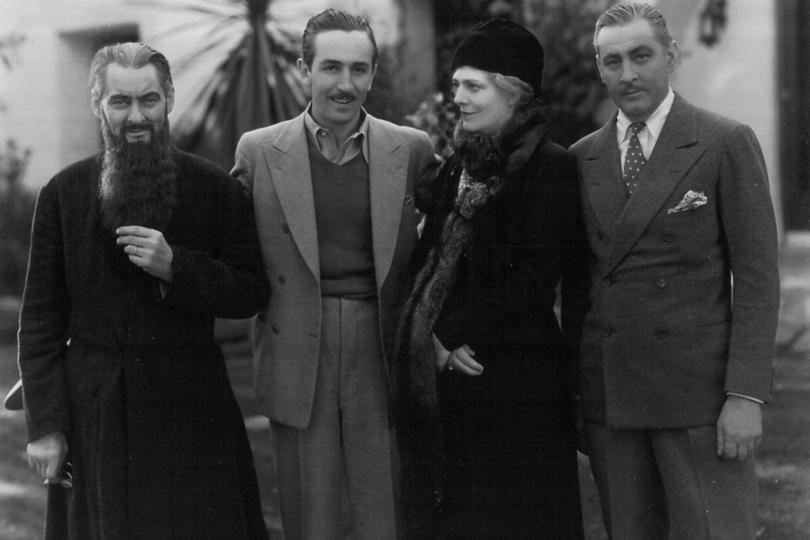The Other Barrymores

At one time or another you’ve listed which ten people from history you’d spend time with at a dinner party. In doing research for this article, I’d certainly invite Lionel Barrymore (1878-1954), because, in addition to being a great actor, his accomplishments made him a genuine Renaissance Man. His award-winning acting career included the Best Actor Oscar in 1931 for A Free Soul, costarring Norma Shearer and Clark Gable, his role as an alcoholic attorney who defends his daughter’s fiancé in a murder trial.
Besides acting, Barrymore wrote novels, composed several pieces of music including Elegies, Rondos, Symphonies and a one-act opera. Hoping for a career as a professional painter, he lived with his first wife, Doris Rankin, in Paris for a time. He toured in vaudeville, starred on Broadway and appeared in early films directed by the esteemed D. W. Griffith when it was considered beneath the dignity of a stage actor to do so. He later invented the boom microphone. Yet, this eldest of the Barrymores remained a very modest man.
While Ethel’s career, (covered in the last article) was largely in the theater, Lionel Barrymore preferred movies. Signed to a long-term contract at MGM, among his costars were Lon Chaney, Shirley Temple, Marie Dressler, and Spencer Tracy. He worked with Greta Garbo four times: in The Temptress, Mata Hari, Grand Hotel (as a dying man who goes on a spree he can’t pay for. The film also featured John Barrymore) and in Camille, as Robert Taylor’s father who doesn’t want a prostitute as a daughter-in-law.
Not everything in Barrymore’s life was ideal. Unlike his younger brother, John (see below), he didn’t really suffer from the “Barrymore Curse.” Following the deaths of their two infant children, he and Doris Rankin were divorced and he buried himself in his work. Along with his siblings, he played the title role in Rasputin and the Empress, a movie that Ethel had bulldozed James MacArthur and Ben Hecht into writing for them. During filming, it’s reported that the siblings fought amongst themselves constantly. He later married Irene Fenwick, a former love of his brother, John and the two brothers had a strained relationship for years after.
With his resonant voice, Lionel Barrymore was often cast as cantankerous old men. This was in keeping with his health. Barrymore suffered from crippling arthritis. Following his performance as the Captain of a fishing boat in Captains’ Courageous, he used crutches in You Can’t Take it with You, but afterwards, never stood again onscreen, using a wheelchair instead. This worked well for his role as Dr. Gillespie opposite Minnesota native Lew Ayers in the Dr. Kildare film serials. His most famous role is that of the corrupt banker Mr. Potter in It’s a Wonderful Life, but his yearly radio performance of A Christmas Carol was beloved by many.
Lionel and Ethel Barrymore hold the honor of being the first brother and sister to win Oscars, and he has two stars on the Walk of Fame. Voice actor Allen Swift copied him for the role of the villainous Simon Bar Sinister for the TV series, Underdog.
Just think, at that dinner party, he’d talk about literature, show his artwork, play some of his music and share stories of the stars. Lionel Barrymore died from heart failure in 1954.
John Barrymore
Although the Barrymores aren’t the only acting dynasty with addictive disorders, they’re certainly the most renowned. Columnists and publicity agents invented new ways of coping with the pranks of John Barrymore (1882-1942), the last of which has become legendary.
The youngest sibling John, like Lionel, he wanted to be an artist. He was educated at King’s College, Wimbledon and at the New York Art Students League and later had a short-lived job as a freelance artist for the New York Evening Journal. It was Ethel who brought him into the theater, but this didn’t last long. Because of his extraordinary talent, producers Weber and Fields put him in vaudeville. This brought him to the attention of a Broadway producer who cast John in an expensive, but successful Richard III. His influential production of Hamlet followed, and the melancholy Dane is something he’d return to frequently, especially when he was broke.
A ladies’ man, he romanced “the girl on the red velvet swing,” Evelyn Nesbitt; he later had an affair with the young Mary Astor while filming Beau Brummell. (Astor’s diaries would eventually make her infamous. She remained a successful award-winning star.)
The Great Profile
While he often worked in the theater, the actor known as “the Great Profile,” was a major star of the silent era as well. His Dr. Jekyll and Mr. Hyde remains every bit as chilling today as it did in 1920. Knowing which roles would be right for him, John Barrymore agreed to play lothario Don Juan, only if he could play Captain Ahab. The result was the exquisite 1926 version of Moby Dick, The Sea Beast.
The Barrymore Curse
It didn’t show in his silent films, but his struggle with alcoholism became more apparent as John Barrymore aged and in his later film and stage work. His dedication to acting changed when he still got good notices while acting under the influence. Barrymore’s personal life suffered as well. His first marriage, to Katherine Corri Harris lasted 7 years; he and writer Blanche Oelrichs, known professionally as Michael Strange were together for eight. (Their daughter, Diana is discussed below). Barrymore’s marriage to actress Dolores Costello seemed to be his happiest, but lasted only six years. With Costello, he had a son, John Drew (see below) and a daughter, Dolores. His last marriage, to Elaine Barrie, lasted four years.
Arguably, John Barrymore’s best performances are those of the robber Baron planning to steal her jewelry while romancing Greta Garbo’s long-suffering ballerina in Grand Hotel and self-destructive actor Larry Renault in Dinner at Eight, (recently staged by Minnesota Opera). However, in 1934, he was cast in two superb roles. As a man released from a mental institution who tries to renew his relationship with his daughter, Barrymore is striking In A Bill of Divorcement, because of his chemistry opposite Katharine Hepburn (her film debut.)
In Twentieth Century, Barrymore was brilliantly cast as Oscar Jaffe, a theater producer in need of a project, who confronts Lily Garland (Carole Lombard), the woman he made a star, on a cross-country trip aboard the famous train. Howard Hawks’ film is one of the greatest of the screwball comedies of the 1930s.
In the last five years of his life, John Barrymore suffered from serious lapses of memory and working with him became increasingly difficult. In 1939, he made his last noteworthy film, co-starring with Claudette Colbert, Don Ameche and Mary Astor in the comic gem Midnight. Sadly, Barrymore’s eyes are vacant, and his performance disjointed.
Death and Aftermath
Barrymore died from complications of pneumonia, as well as cirrhosis of the liver and kidney failure. He wished to be cremated and have his ashes interred with his parents in Philadelphia. Instead, he was buried in Los Angeles. The night before his funeral, W.C. Fields, Raoul Walsh and Barrymore’s other drinking buddies pulled the ultimate spree. They “borrowed” the corpse and took it to the home of Errol Flynn, where they propped it up with a glass of whisky. They toasted him a several times, and left. When Flynn arrived home, and saw the corpse, he screamed himself sober and didn’t sleep that night. Barrymore’s son would later move his father's body to Philadelphia. A restaurant on W. 45th Street was named for him, but, a victim of urban development, it’s been closed, leveled, and is now a parking lot.
Diana Barrymore, 1921-1960
Hoping to give his daughter a better life (and to deter her from the “curse”), Diana Barrymore was sent to boarding school in Paris. She rebelled by wearing revealing clothes to a party, causing her to become determined to grow-up. After returning to the U.S., Diana Barrymore attended the American Academy of Dramatic Art, unsuccessfully tested for Gone with the Wind, and wound up in the Chicago cast of Outward Bound which played the theater opposite where her father was appearing, thus causing an awkward family reunion.
Five Broadway appearances, most of them only lasting a week or two, led to working onscreen with Robert Stack. However, she was something of a prima donna, refusing to work with lesser talents. In spite of being named New Screen Personality of 1942, she was suspended by the studio.
Diana was with her father the night he died, but suffering from poor self-esteem, thought she was washed-up at 23. Following another road tour and two failed marriages, she and her third husband, who claimed to be a recovering alcoholic, lived off her trust fund. A short-lived stint on television led her to Australia, where she had minor success. After an affair that ended in violence and being blacklisted, she went into rehab and returned to work sober.
Her autobiography, Too Much, Too Soon, brought her some attention, especially when it was poorly filmed with Dorothy Malone as Diana and Errol Flynn as John Barrymore. While she reconnected with some of her family in the last years of her life, sobriety didn’t last and she died at the age of 38 in 1960.
Breaking the Curse
While John’s son, John Drew Barrymore, followed his father’s wishes and had his body moved, his own life was a series of ups and downs. He acted in low-budget movies, but his career never really advanced. Frequently busted for drugs, he wound up a derelict, living in a shack when his daughter, Drew Barrymore, found him. Dying of cancer, despite being estranged, she paid for his treatments until his death. Her own childhood brought back the “Curse,” early in Drew Barrymore’s life. She fell into an uncontrolled life of making movies, while displaying an addictive personality. Following three stints in rehab, the young star of E.T., has become a respected actress, producer, writer and director. She’s addressed her troubles and has been named United Nations Ambassador Against Hunger.
Time will tell, regarding the fate of the Barrymores, but their legacy will always be with us (thanks to their movies). They are among the great acting talents of all time!
Biographies
John Barrymore: The Life of John Barrymore by John Kobler
We Barrymores by Lionel Barrymore
Too Much, Too Soon by Diana Barrymore and Gerald Frank




